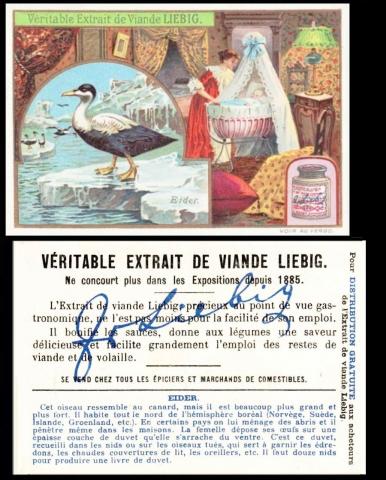
The Eider is very heavy, perhaps because its feathers are so tightly packed - but oddly it is also the fastest duck in flight of them all. You will mainly find them on the coasts, where shellfish, its favourite food, is more prevalent.
We know them most for the fact that their feathers are used in proper eider-downs. Most of these feathers are collected, quite kindly, from the nests after the breeding season is over. This is possibly how it came to be discovered that they were warm and comfortable, and so the idea began to sew them in a cover and use them on a human bed. As far as when the collecting began, we are not sure, but we do know that the Vikings used them for warmth on their sea journeys.
Each card has the bird in a frame and then a scene of how it is used as the main image. The cards are unnumbered, but show the following :
- Carrier Pigeons (flying from a ship to deliver a message)
- Chickens and Turkeys (for Christmas meat)
- Eider (for feathers for bedding)
- Hummingbird and Ostrich (for feathers for hats)
- Pheasants (for food)
- Seagulls (for guano)
This set was issued in France and Belgium under the same title as here, "Oiseaux Utiles" - in Germany as "Nutzgeflugel" - in the Netherlands as "Nuttige Vogels", and in Italy as "Uccelli Utili". As far as values the Belgian version is much more easily available, and therefore the cheapest, at around £5-10 a set, whilst the most expensive is usually said to be the one from the Netherlands, at about £50. The set was also issued in Spain, but this version is extraordinarily rare, so rare that I have not even been able to find out the title.
